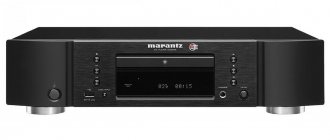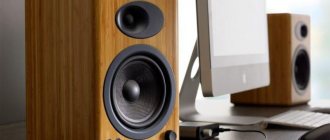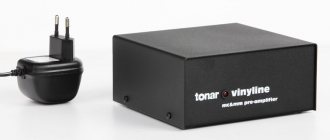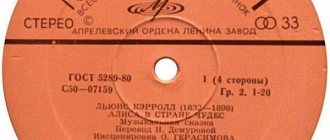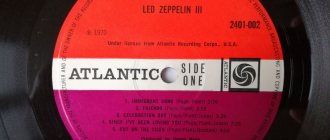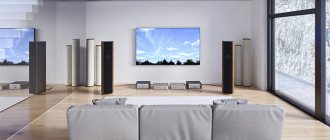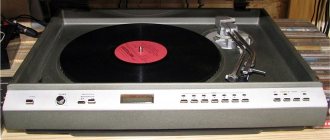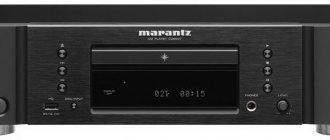The topic of perfection of musical equipment is truly inexhaustible; you can delve into it all your life and still not understand anything. The whole point is that it (the topic) is at the intersection of technology and art; surrounding reality and tastes; complexity and aesthetics. Therefore, let’s not consider all the smallest nuances now, but simply accept the fact that vinyl is not an ideal or the most practical source, but for a combination of various reasons, nothing more beautiful has yet been invented. Thanks to this, having completed a technological revolution, the music industry is returning to normal, and records are once again gaining their unprecedented popularity. Let's see what devices the industry can offer us now. The main criteria when choosing the best vinyl player in 2022, in addition to the technical component, for me are also availability on the market (you can buy in one click, rather than looking for and waiting for months) and readiness to work right out of the box without long painful setup and understanding the materiel.
Top 10 rating according to KP
Editor's Choice
Audio-Technica AT-LP120XUSB (average cost 29 thousand rubles)
Audio-Technica AT-LP120XUSB.
Photo: market.yandex.ru An excellent player, very loved by music lovers for its good technical equipment and sound. The design is not very interesting, externally it’s just a clone of the Technics SL-1200, with the only difference being that the body here is made of plastic, while the progenitor’s case is made of aluminum. It has a direct drive, quartz speed stabilization, is equipped with a good initial Audio-Technica AT-VM95E cartridge, has a built-in switchable phono stage, an S-shaped tonearm with the ability to replace the head, the turntable is classified as a DJ turntable, so it has additional functions, for example, pitch (manual speed control rotation) and forced shutdown of the engine. There is also a USB connection so you can digitize your records.
Specifications:
| Drive unit | straight |
| Speed | 33, 45, 78 rpm |
| Phono stage | yes, switchable |
| Control | manual |
| Anti-skating | There is |
| Cartridge | AT-VM95E, replaceable |
| Lid | There is |
Advantages and disadvantages
Equipment, reliability
Weak damping
show more
Pioneer DJ PLX-500 (average price 25-29 thousand rubles)
Pioneer DJ PLX-500. Photo: pioneerdj.com
Another DJ device, also a successor of the Technics SL family. In all respects it is a direct competitor to the AT-LP120. In general, we can say that the competitor turned out to be good, but there is still a difference. It costs a little less, but we saved on the cartridge. The disadvantages include a non-removable audio cable. Despite mixed reviews, it’s still worth adding that 25 thousand rubles is actually a fairly modest price for a player, so you shouldn’t expect any super-duper characteristics. The cartridge costs the cheapest Audio-Technica AT-91, so it’s immediately clear what needs to be improved first. Otherwise, the player pleases with its functionality and price/quality ratio.
Specifications:
| Drive unit | straight |
| Speed | 33, 45, 78 rpm |
| Phono stage | yes, switchable |
| Control | manual |
| Anti-skating | There is |
| Cartridge | AT-91, replaceable |
| Lid | There is |
Advantages and disadvantages
Equipment, fixed wire
The cheapest replacement cartridge
show more
Pro-Ject T1 Phono SB (average price 30 thousand rubles)
Pro-Ject T1 Phono SB. Photo: projectaudio.ru
This company always pleases with the fact that even in inexpensive models they save on sound, not at all. To reduce the cost of production, they sacrificed the possibility of an upgrade. At the same time, the turntable comes from the factory fully configured for use, with an excellent Ortofon OM-5E cartridge, a proprietary, really good switchable phono stage. The design is as minimalistic as possible, looks noble and solid.
Specifications:
| Drive unit | belt |
| Speed | 33, 45 rpm |
| Phono stage | yes, switchable |
| Control | manual |
| Anti-skating | No |
| Cartridge | Ortofon OM-5E, non-replaceable |
| Lid | There is |
Advantages and disadvantages
Sound, design
There is no possibility to change the cartridge
show more
What other vinyl players are worth paying attention to?
Audio-Technica AT-LP60XUSB (average cost 11-14 thousand rubles)
Audio-Technica AT-LP60XUSB. Photo: market.yandex.ru
An inexpensive and reliable entry-level player, suitable for those who are just exploring the world of analog sound. Everything is very ascetic and made from inexpensive materials, and you don’t need to do anything with it - it’s fully automatic, just press a button and listen. There is a USB connection through which you can transmit sound. The turntable comes with a branded cartridge that cannot be replaced, the sound is unremarkable, but it is completely worth the money.
Specifications:
| Drive unit | belt |
| Speed | 33, 45 rpm |
| Phono stage | yes, switchable |
| Control | machine |
| Anti-skating | No |
| Cartridge | ATN3600L, non-replaceable |
| Lid | There is |
Advantages and disadvantages
Easy to use, audio wire cannot be replaced
Cartridge cannot be replaced
show more
Rega Planar 1 (average cost 25-30 thousand rubles)
Rega Planar 1. Photo: market.yandex.ru
An excellent player whose philosophy is in many ways similar to the Pro-Ject T1. It’s also a very minimalist, noble design, a simplified design, where you can’t get away with an upgrade. At the same time, the Rega Carbon head is already installed from the factory and configured for use - budget, but very worthy. Anti-skating here is preset at the factory and cannot be adjusted manually, the shell cannot be changed either, but replacing the pickup is possible, but it is assumed that few people will do this in a player of this level.
Specifications:
| Drive unit | belt |
| Speed | 33, 45 rpm |
| Phono stage | No |
| Control | manual |
| Anti-skating | yes, preconfigured |
| Cartridge | Rega Carbon, conditionally replaceable |
| Lid | There is |
Advantages and disadvantages
Design, price/quality
Little potential for upgrade
show more
Thorens TD-202 (average cost 67 thousand rubles)
Thorens TD-202. Photo: market.yandex.ru
Time to up the ante a little, right? This Swiss company is the oldest manufacturer of turntables; books have been written about its glorious history. It was always cool and expensive, the Rolls-Royce of turntables. The TD-201/TD-202 line was released in 2018 after major changes in the company and its actual revival. They are more affordable both in price and in design, but have not at all lost their historical monumentality. The player is ready to work out of the box and at the same time has great potential for improvement. It has a built-in phono preamplifier and an AT-95E driver, which you could say doesn't really live up to the coolness of this unit. In fact, you are buying an excellent platform where you can install an expensive cartridge, connect with high-quality removable wires to a good phono stage and get luxurious, expensive sound.
Specifications:
| Drive unit | belt |
| Speed | 33, 45 rpm |
| Phono stage | yes, switchable |
| Control | manual |
| Anti-skating | There is |
| Cartridge | AT-95E, replaceable |
| Lid | There is |
Advantages and disadvantages
Quality, reliability, excellent upgrade potential
The cartridge does not match the level of the player
show more
Technics SL-1210 mk7 (average cost 99-110 thousand rubles)
Technics SL-1210 mk7. Photo: market.yandex.ru
Long live the king! The glorious history of this family of players has been going on for almost 50 years. There is probably no more popular and famous turntable on the planet. One of those devices that you buy once and for life. SL-1210 stands in London's Science Museum as one of those things that "shaped the world we live in." These players influenced the entire music culture and industry. DJing, hip-hop and electronic music appeared and developed with the help of this device. His merits can be listed endlessly. In this case, we are dealing with an updated version of the legend and it turned out to be very worthy. Traditionally, the turntable comes with a blank shell, leaving the user to choose a cartridge to suit their tastes and needs. Otherwise, everything is exactly as it should be: direct drive, quartz stabilization, many fine adjustments, complete stuffing and uncompromising workmanship.
Specifications:
| Drive unit | straight |
| Speed | 33, 45, 78 rpm |
| Phono stage | No |
| Control | manual |
| Anti-skating | There is |
| Cartridge | replaceable, absent |
| Lid | There is |
Advantages and disadvantages
Ideal in everything
Expensive
show more
Yamaha MusicCast Vinyl 500 (average cost 49 thousand rubles)
Yamaha MusicCast Vinyl 500. Photo: ru.yamaha.com
Externally, it's just a pretty nice player with a rather ascetic design, covered with a beautiful black varnish. Everything is classic: belt drive, removable shell, inexpensive Audio-Technica head, fully automatic, on-board phono stage, anti-skating, and so on. But if you take a closer look, you will notice Wi-Fi and Bluetooth indicators, a Connect button, and an Ethernet network connector on the back. But this is something new! So who are you really? This is a streamer, that is, a network player that can connect to wireless speakers, broadcast music over the network, be controlled from a smartphone via an application, connect to it via Bluetooth and be used as a player, play music from popular streaming services. At the same time, it still works perfectly just as a turntable through the usual wires. Very brave!
Specifications:
| Drive unit | belt |
| Speed | 33, 45 rpm |
| Phono stage | yes, switchable |
| Control | machine |
| Anti-skating | There is |
| Cartridge | replaceable from Audio-Technica |
| Lid | There is |
Advantages and disadvantages
Very technologically advanced
If you don’t need all these bells and whistles, then you shouldn’t overpay for them.
show more
Pro-Ject Juke Box E (average cost 38-42 thousand rubles)
Pro-Ject Juke Box E. Photo: projectaudio.ru
This player is made in much the same way as all budget Pro-Ject players: belt drive, pre-tuned tonearm with an Ortofon OE-5M head, cat Phono stage: yes, switchable or not supposed to be changed, simple nice design, built-in phono stage, manual control. What catches your eye is a small screen next to the tonearm and a knob in the front. Yes, this is not just a turntable, it is a combine with a built-in 50-watt amplifier and Bluetooth support for playing music from other sources. An unusual and interesting device, you just connect it to the speakers and go!
Specifications:
| Drive unit | belt |
| Speed | 33, 45 rpm |
| Phono stage | yes, switchable |
| Control | manual |
| Anti-skating | No |
| Cartridge | Ortofon OM-5E |
| Lid | There is |
Advantages and disadvantages
Harvester, decent sound
Legacy Bluetooth
show more
Onkyo CP-1050 (average cost 47-49 thousand rubles)
Onkyo CP-1050. Photo: onkyo.ru
A very beautiful player with a strict retro design. It has direct drive with quartz stabilization, manual control, S-shaped tonearm with anti-skating. The turntable has great potential for improvement. The original OC-105 cartridge let us down. This inexpensive entry-level head does not correspond to the class of the device.
Specifications:
| Drive unit | straight |
| Speed | 33, 45 rpm |
| Phono stage | No |
| Control | manual |
| Anti-skating | There is |
| Cartridge | OC-105, replaceable |
| Lid | There is |
Advantages and disadvantages
Design, quality, potential for upgrade
Immediately replace the cartridge with something decent
show more
Choosing a budget turntable: “warm” vinyl compromises up to 15 K rubles
Today, many people firmly associate vinyl and everything connected with it with high cost, “snickering audiophiles,” astronomical prices for collectible vinyls, or, at best, with the fashionable aspirations of pretentious hipsters. The stereotype is so strong that the first comment to our previous article “about the paradox of the vinyl trend” was the following:
“They're freaking out about fat. There's nothing more to say"
Meanwhile, the stereotype has long been untrue.
This post is for those who intend to buy a decent turntable, but are not ready to invest astronomical amounts in the components. To ensure that the cost does not cross the psychological barrier of even the most economical clients, I limited the budget of a hypothetical buyer to 15,000 rubles. The review included only home turntables with a built-in phono stage, which, in my opinion, corresponds to the wishes of the majority of users of budget turntables.
I believe that the publication will be useful to potential buyers and will not affect the delicate spiritual organization of haters of commercial content (we are, after all, a trade organization and will be grateful for your loyalty). I, in turn, will try to reduce the degree of “warm” vinyl pathos as much as possible. The selection of products for review was made based on availability in the pult.ru catalog and cost (see above). The sources of information for the post were documentation for the devices, customer reviews on yandex.market, as well as personal user experience. When writing the post, I tried to abstract as much as possible from the marketing component in the descriptions of manufacturers, attachment to brands and pay attention to the advantages and disadvantages of specific models (it worked almost everywhere).
Good and bad news
For those who want to count about specific models, I recommend scrolling down and then going back.
I'll probably start with the bad news. Very budget players are always a compromise between a very attractive price and a number of tangible shortcomings. The main problems are related to imperfect playback mechanics, low weight of the device, distortions (sometimes minor, and sometimes noticeable) and a higher risk of defects in the situation with noname devices from the Middle Kingdom.
A common problem with almost all inexpensive players is their low weight (often less than 3 kg). This means that during playback the turntable will respond to vibration. When installed on vibrating surfaces, playback problems are possible, which is not natural for the electromechanical type of playback. In other words, if the floor is not marble, then you will hardly be able to cheerfully dance to vinyl playing on a budget player.
Almost all state employees have a drive (belt). Passengers periodically stretch and require replacement; fortunately, they are not expensive. DJing with scratching is contraindicated for such players. Belt drive has its advantages
: Lower detonation and less rumble. However, direct drive in this price range is almost a casuistry.
Stability of rotation speed is another parameter with which budget players may have problems. In the case of the players presented below, this is noticeable only to very experienced listeners
, in cases with Chinese
noname for 2000 rubles
- this almost forever discourages listening to anything on vinyl. I do not suffer from brand addiction, but my personal impressions are very bad and I have never heard any positive reviews about this category of devices. Most models in the range up to 15 have 2 standard modes 33/45 rpm. per minute In some models, 78 rpm are implemented. per minute
Typical Chinese noname
Modification Most budget devices cannot be significantly modified in any way. As a rule, the needle is replaced. I have never seen the possibility of replacing the tonearm in this price category (I’m afraid to make a mistake here, there are different things in the world, but with a high degree of probability this is so).
It may seem to some that I am exaggerating too much. May management forgive me for my disloyal attitude towards products!
I can reassure you that, depending on the model, you may encounter one or two problems or not feel their significance at all.
Functionality and integration. Problems with this part are possible, but their likelihood is much lower. As a rule, even budget models have a sufficient number of interfaces, automatic control, and good ergonomics. There are models with Bluetooth, which makes integration easier, but analogue audio adherents consider all these things to be “not true.”
And now we can talk about good things. The main advantage is, naturally, the price, since the cost of the basic lines starts from a modest 5-6 wooden K. The design of modern budget players is very impressive and varied, from vintage nostalgic motifs to modern minimalism. For obvious reasons, it will not contain expensive materials, but the heavier the table parts used, the better. These devices often do not require any complex adjustments. A simple principle: buy, charge the reservoir - listen.
Pioneer PL-990
About the good
The price of the device is 12,990
. According to many who left reviews on the mockup, the device has no shortcomings for such a price. The straight tonearm is resistant to resonance, which partly compensates for the influence of the lightweight plastic table. The phono stage does not significantly distort the sound and is equipped with an equalizer, which is really good for the money. I don’t mention any microdynamics and influence on the nuances of the scene, because it’s a sin. Automatic control. Judging by the reviews, the device is reliable (most users use it for at least 4 years without any repairs), which is surprising considering the cost. The device is simple, understandable, and convenient. Low detonation level 0.025%.
About the bad
The speed floats (it feels like the manufacturer does not indicate the deviation parameter) - this is due to the lack of a built-in voltage stabilizer. The weight of the plastic case leaves much to be desired. The sad thing is that the signal-to-noise ratio is 50 dB, which in principle is tolerable, but is far from the limit even for a budget device. A short interconnect (1.1 m), soldered into the board. The phono stage does not turn off, which makes it impossible to use an external device.
Specifications
• Weight, kg: 2.65 • Head type: MM • Table color: black • Warranty: 1 year • Number of motors: 1 • Rotation speed: 33.3/45.0 • Control: automatic
• Motor: built-in • Speed switching: manual • Number of tonearms: 1 • Table material: plastic • Drive type: belt drive •
detonation level 0.025%
• Signal-to-noise ratio: 50 dB
Bluetooth: ION Audio Air LP
About the good
Price: 8,990
. A fairly heavy table made of MDF – 3.7 kg. Possibility of transmitting sound via Bluetooth (the manufacturer claims that this is the first Bluetooth vinyl player). USB interface. Removable interblock. The device is convenient from an ergonomic point of view. Important point: one of the few budget players with a speed of 78 rpm. The sound corresponds to the price category of the device (no more, no less). Automatic stop, but without other automatic equipment.
About the bad
Like the Japanese pioneer described above, the American ION can be a little weird with speed. According to a number of reviews, the hitchhiking mechanics may malfunction after prolonged use. Not for advertising, but in fairness: I didn’t find any reviews about terrible mechanical breakdowns. The phono preamplifier raises the high frequencies and does not sufficiently preamplify the midrange (very subjective, the frequency response of everyone’s ears is different), the problem is solved by equalization at the next stage of the tract.
Some technical characteristics
• Weight: 3.7 kg
• Head type: MM •
Number of USB inputs: 1
•
Blootooth
• Number of motors 1 • Rotation speed: 33.3/45.0/
78.0
• Control: automatic • Analog cable: detachable • Switching speeds: manual • Number of tonearms: 1 •
Table material: MDF
• Disc material: plastic • Drive type: belt drive • Signal-to-noise ratio: 55 dB
Denon DP-29F - alloy wheels are back in fashion
About the good
Price: 9,990 rub.
Cast aluminum support disk - accordingly, normal geometry is guaranteed. The phono preamplifier is quite tolerable for my ears and does not introduce terrible audible distortions. Reliable automation. According to the manufacturer, the pressure of the clamping head on the formation is adjusted in such a way as to prevent the appearance of scratches. The signal-to-noise ratio is 60 dB, detonation is 0.15%, which is already good for a budget turntable. The first few months it spins at a stable speed. Structurally, it is very simple, which makes it less likely to break than others. Automatically switches speeds. It is equipped with speed control, which, in terms of fine-tuning capabilities, compares favorably with most price analogues.
About the bad
Sensitive to vibration, which is due to its small 2.8 kg weight. Heavy support disk, with relatively low engine power. Integration is inferior to many devices; there is no USB or Bluetooth. Non-removable and short cable, non-removable shell.
Characteristics:
• Weight, kg 2.8 • Head type: MM • Number of motors:1 • Rotation speed: 33.3/45.0 • Control: automatic • Analogue cable: removable • Speed switching: automatic • Number of tonearms:1 • Disc material: metal
• Drive type: belt drive •
Speed adjustment: yes
•
Signal-to-noise ratio: 60dB
Teac TN-100: personal preference
I will not talk modestly about my personal sympathies. The designers of this device have combined almost all the possible advantages that a budget player in the segment up to 15,000 can have. About the good
Price: 13,730.
One of the main advantages is anti-vibration properties. The case is made of MDF, the weight is more than respectable for a budget turntable - 4.9 kg, with an additional damping layer of neoprene on the disk. All these features make the turntable almost insensitive to everyday vibration levels. Footsteps around the room and furniture resonances are not scary for this device.
A good corrector, optimally adjusted to the used Chuden Teac Original Version GS head. Signal to noise ratio, dB: 67. Anti-skating is also a rare feature for budget models (it doesn’t always help, but it’s better than without it).
High speed stability (speed deviation no more than 2%), which is achieved due to a stably operating engine and precise finishing of a steel bearing installed in a bronze cup.
Functional and integration advantages include the ability to switch operating modes with and without a built-in phono stage, a USB interface and an A/D converter, the ability to play shellac at 78 rpm, a removable cord, and automatic speed switching.
About the bad
The support disk is made of plastic, which is considered a disadvantage by many. No Bluetooth integration. As I already wrote, minor problems with speed stability are possible; after long-term use, this can be treated by replacing the belt.
Specifications:
• Weight: 4.9 kg • Head type: MM • USB outputs: 1
• Number of motors: 1 • Rotation speed: 33.3/45.0/
78.0
• Speed switching: automatic •
Table material: MDF
• Disc material : plastic • Drive type: belt drive •
Signal-to-noise ratio: 67 dB
•
Speed change no more than 2%
Using the examples of the models presented in the review, you can easily understand what difficulties the buyer of a budget turntable will encounter, as well as what benefits he can gain (the most representative models were chosen, the advantages and disadvantages of which are inherent in most entry-level players). In addition to those described above, in this price segment there are models from such manufacturers as: Sherwood, Audio Technica, AKAI, Marantz, Sony, Dual
.
I do not rule out that I may have overlooked something important and I would be grateful for comments that will help to fully explore the topic of the advantages/disadvantages of budget players.
You can learn more about the range of budget players by following the link
How to choose the best player
Drive unit
At the moment, there are two main types of drive: belt (pass) and direct.
Direct Drive means that the motor is located under the platter (the plate on which the record is placed) and is directly connected to it. This is a very reliable design that has many advantages, such as: quick start and stop of the disk (there will be no “mooing” during acceleration), high stability of operation (the speed does not fluctuate), and the absence of fragile elements. The disadvantages include a fairly high level of detonation, which means that a motor connected directly to the disc during operation can transmit some of the vibrations to the record, which will have a bad effect on the sound quality, so a well-implemented direct drive will be relatively expensive.
A belt drive means that the torque from the motor to the support disk is transmitted using a belt; this design also has its pros and cons. The main advantage is that at a low cost you can achieve impressively low detonation, because the motor does not transmit vibration to the disc. An important feature of a belt drive is its smooth operation; the disc spins and stops more slowly; it is believed that it treats the plates more gently, which means they will last longer. The downside is that the belt can wear out and stretch, which means it needs to be changed regularly. In addition, the stability of the rotation speed is also not its strong point.
Previously, there was a third type of drive - roller. But it is expensive and complicated, and the advantages are quite dubious; now it is difficult to find such a turntable. There are other types of drive, but they already belong to perversions loosely related to listening to music.
Cartridge
There are two main types of cartridge (head): MM and MC. They use the same principle of electromagnetic induction, but have some design differences. Honestly, a description of the design of the pickup is worthy of a separate article, because it is, in fact, the most important part in the player. Therefore, I propose to consider only the pros and cons of these designs.
MM (moving magnet) cartridges are the most popular, their initial price is low, they are more universal and omnivorous to the genres and quality of recorded music on a record, they forgive mistakes for beginners because they better withstand harsh use, in most heads you can replace the needle (it is still called "insertion"). You can change the needle due to wear or breakage, and for some cartridges you can buy an insert with a different type of sharpening (yes, yes, there is also room for engineering development here).
MC (moving coil) cartridges are the first sign of a disease called “audiophilia”. A joke, albeit with some truth. It is believed that these cartridges convey sound in more detail, are more sensitive to the quality of the media and, as a result, are more capricious and fragile. They tend to be more expensive than MM cartridges and require a different type of phono stage. You should not immediately buy such a cartridge; it does not forgive mistakes for inexperienced users.
There are several other types of cartridges such as MIMC, MMC, etc., but I guarantee you that you will know exactly when you are ready to hear about them.
Nowadays players with piezoelectric heads are still produced. Such devices are very cheap and popular, but, believe me, they do not deserve any attention, this is a very old and low-quality technology, used, for example, in primitive Soviet electrophones such as “Yunost 301”.
It is worth noting that the ability to select and replace a cartridge should be in every self-respecting player, although there are decent inexpensive turntables that do not offer this, for example, in younger models from Pro-Ject. This is simply a ready-made configuration that is as cheap as possible, which also sounds good, so there is no need to interfere with it.
Tonearm
The two most popular types are straight and S-shaped.
A straight tonearm is lighter, simpler, easy to configure and upgrade the cartridge, but has a so-called tracking angle error. This means that during playback, the position of the stylus relative to the record changes unevenly, which theoretically can cause slight sound distortion in the extreme positions of the tonearm, but in practice this is difficult to encounter. Even monstrously expensive turntables have straight tonearms; engineers are obviously not very worried about this problem. The S-shaped tonearm is designed in such a way that this error does not occur, however, it is heavier, so you should be a little more careful in choosing and setting up the cartridge if you change it.
Of course, we are talking about average models. In fact, there are heavy straight tonearms, and light S-shaped ones, and what not.
There are also, for example, tangential tonearms, but these are very complex, rare and expensive devices; I won’t describe them, because you won’t find them in stores anyway.
A sign of a good player is the presence of anti-skating. There is such a thing as “skating” - this is a force that, in accordance with certain laws of physics, pulls the turntable needle towards the axis of rotation, because of this it can come into contact with the record at the wrong angle and this will negatively affect the sound. Anti-skating is designed to compensate for this force. In general, at the very beginning of your music lover’s journey, this function can be neglected.
Automation
We divide them into three main types: automatic, semi-automatic and manual (almost like washing machines).
Automatic means that you just press a button, then the tonearm itself moves towards the record, lowers the needle, and at the end of playback it returns to its place.
Semi-automatic is, as a rule, only automatic return of the tonearm, and its feeding is carried out manually.
Manual control means that you have to do everything yourself.
There is no better option here. The presence of any automation complicates the design of the turntable, therefore, it will either cost more or work poorly. Whether you are ready to overpay for this or spoil the records is up to you. Manual control requires a certain accuracy; there is a risk of ruining something yourself.
But that's not all
As you can imagine, the player is just the tip of the iceberg. In order to listen to music on records, you will need several more devices, without which it will be of absolutely no use. In fact, the chain will look like this: turntable - phono stage - amplifier - speakers.
As we have already found out, vinyl is a rather specific musical medium. One of its features is that the sound is recorded with some defect. That's how it should be. Don't get into it. Just remember this fact. So, a phono stage is needed to restore it back. The quality of the sound also greatly depends on the quality of the phono stage. It can be in the form of a stand-alone device, it can be built into a speaker amplifier, or it can be built into a turntable. The built-in phono stage is a sign of an entry-level player; it doesn’t sound very good, but it’s good for the first time. And so that you don’t have to change the turntable when you get to a decent phono stage or integrated amplifier, make sure that it can be turned off. It’s strange, but for some reason not all models have this option.
Why do we still want to listen to records, despite all these difficulties?
It’s probably worth writing about this, because at some stage your enthusiasm may be dashed by harsh reality. There is a joke among music lovers: “There are two things that really attract me to vinyl: the high cost and the inconvenience.” There is indeed truth in this: equipment and records are not cheap, it is essentially a rather cumbersome and complex system, and the process of collecting and listening itself requires a certain level of involvement and the acquisition of some specific skills. But if you love music enough, all this will not be important to you, since it will open up a completely new facet of it. You probably noticed that the text deliberately does not say whether there is a difference in the sound of vinyl compared to other sound media, and what it is. In fact, this was done only because this issue is simply not questioned. Moreover, you will be surprised when you actually discover it.
What else will you notice when you start diving into the world of vinyl records? Firstly, you will suddenly discover that the disc itself, its design, cover, all kinds of tabs, posters, stickers, etc. - this is a continuation of the author’s creative plan, which will allow him to be discovered from a new side, this will be a certain new level of interaction between the performer and the listener. In addition, vinyl accustoms the listener to more thoughtful consumption of content; you will want to spend money exclusively on the music that you really love, and I simply cannot describe the delight of owning your favorite recording here.
It's no surprise that people still listen to music recorded decades ago; it truly was beautiful. However, you've probably noticed that when listening via streaming or in digitized form, old recordings sound rather poor compared to modern ones? As a rule, this sound has nothing in common with what you will hear when you turn on some old record on good equipment, most likely you will be amazed at how alive and powerful it will sound. And here, for me personally, another thrill begins: the opportunity to hear that very recording in the form in which people heard it then, and in which it was originally intended by the creators. Believe me, it's very interesting.
TOP 10 most expensive vinyl players
The annual Record Store Day is approaching. By this date, What Hi-Fi? prepared a review of the ten most expensive “turntables” in the world. There's a lot to see here
JC Verdier La Platine Magnum. Photo: jcverdier.com
Over the years, through the testing laboratories of What Hi-Fi? There have been many different players - from excellent budget models with excellent price-quality ratio to representatives of the High-End sector, thanks to which the most familiar and beloved records sounded in a new way. However, there is also a class of super-expensive players that rarely make it into our reviews, since we strive to mainly present models that are affordable to our readers.
The £30,000 Kronos turntable is one of the most expensive What Hi-Fi? has tested, but many in this review beat it by several times the price. Perhaps this is just luxury for show, but who can guarantee that these technologies will not sooner or later find application in models of a more affordable category for a wide range of fans? We hope so with all our hearts. Whether it's a dream piece of equipment or a brilliant example of cutting-edge technology, these are perhaps the most expensive turntables ever seen.
TechDAS Air Force One - £75,000
Photo: techdas.jp
Airy by name - and airy by nature. How many turntables do you know in which the platter is supported by an air bearing and the suspension is isolated from the support by an air cushion? And it doesn't stop there; Owners of warped vinyl (we also suffered from this misfortune) will appreciate the ability of TechDAS to tightly press the record to the support disk, simplifying the operation of the cartridge.
Clearaudio Statement v2 - £92,500
Photo: clearaudio.de
Statement v2's layered construction is made from bulletproof wood and aluminum plates; The turntable can accommodate up to four tonearms, including the Statement TT1 v2 tangential tonearm for £18,500 (if you have spare change left over after purchasing the turntable). Unlike the TechDAS model based on an air bearing, Clearaudio chose a floating platter suspension based on magnets. There are also more affordable players of this brand on sale.
JC Verdier La Platine Magnum - £95,000
Photo: jcverdier.com
La Platine is simply huge: it has a 50-centimeter platter (in the photo it houses a 12-inch record), and it weighs a whopping 400 kilograms thanks to its granite base. And no matter how you feel about the device's design, it definitely looks better than the company's website.
Continued on next page
Read more…
Add BFM.ru to your news sources?


